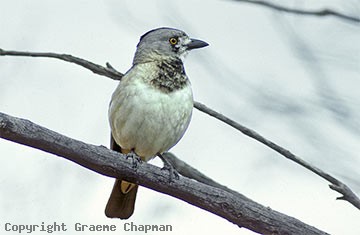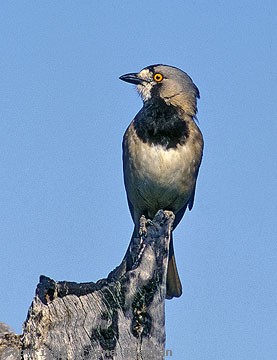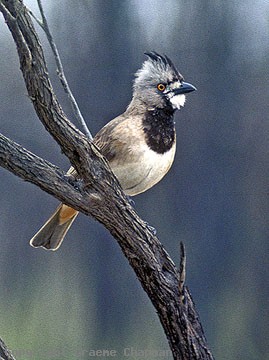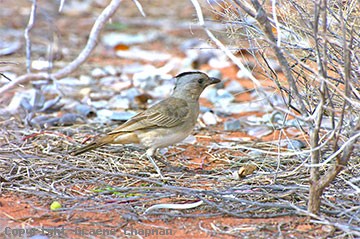
Crested Bellbirds are well distributed throughout the drier regions of Australia, particularly in scrublands dominated by Acacia, but absent from parts of the sandy deserts where there is no suitable habitat.
Their superb songs ( listen on sound page ) will be familiar to anyone who lives or travels in the inland - at full volume the males can be heard from over half a kilometre away, but the majority of people have never actually seen the bird. This is because Crested Bellbirds keep a low profile. Much of their life is spent on the ground in amongst the scrub, hopping along in search of food. They live as pairs in permanent territories which seem to me to be quite large for a bird of their size. Territory sizes can easily be estimated by surveying the singing males in the early morning. Various surveys have been made and the size of territories ranges from about two to nearly ten hectares depending on the terrain, but around three to four hectares seems more usual.
The closest relatives to the Crested Bellbird are the shrike-thrushes. One of the indicators is the similarity of their nests and eggs. Look at pic # 419003 and under Grey Shrike-thrush, pic # 408207.
Female Crested Bellbirds keep an even lower profile - virtually plain grey birds (they can easily be mistaken for a Grey Shrike-thrush) they only occasionally join in song with a male. They seem to be quite shy and are not seen very often, certainly not by me.
An interesting aspect of their natural history is the habit of sometimes placing hairy caterpillars around the outside (and in?) the nest - they nip the caterpillars to render them immobile so they can't crawl away. This is something I've never seen although I have found a number of nests over the years - I guess hairy caterpillars are not always available. The reason for this odd behaviour has been subject to much conjecture. They do occasionally eat hairy caterpillars (a lot of birds don't!) so it has been suggested it is simply an extra supply of food but the most plausible reason to me is that the grubs are placed there as camouflage for the young nestlings. Have a look at pics #s 419209 & 419211 and imagine looking at the nestling from above - very hairy indeed!









